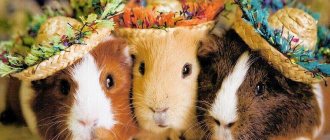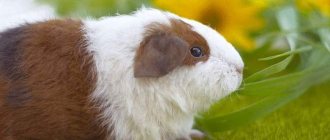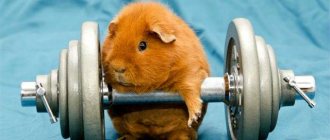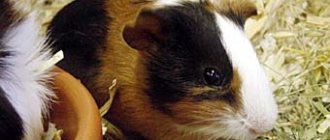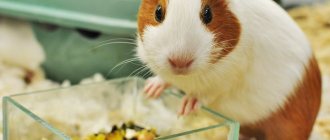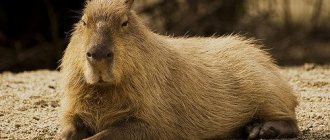Author Sergey Bukhransky
01.02.2019 09:00
Zoosphere » Rodents
Guinea pigs are simply created to be pets. The animal is small and at the same time very interesting. The guinea pig itself is very friendly, but it does not immediately become tame. You need to put in a little patience and love, then the animal will pay you triple.
Adaptation to a new place
Until the animal feels completely safe, all attempts to tame a guinea pig will be in vain. Therefore, in such an important matter, you need to be patient, provide your pet with comfortable and calm conditions, and wait until he gets used to the new living conditions.
First of all, some conditions must be met:
- You cannot make noise near the cage;
- the drinking bowl and feeder should always be full;
- you need to arrange a shelter: a heap of hay behind which the animal will hide;
- the new resident must be isolated from other pets;
- people do not need to pet or forcibly hold the animal in their arms.
At first, the animal will naturally try to avoid contact with people. In the presence of strangers, the pet may even refuse food.
To facilitate the adaptation process, you can cover the cage or enclosure with a thin cloth.
Even if the pet does not show its anxiety, the owner must be as delicate and careful as possible.
The animal should not be disturbed for no reason, it should not be picked up, and there should be no sudden movements when cleaning the enclosure. In the first days of living in a new place, it is not recommended to let the animal walk around the apartment, because it may not find its way back. And the process of catching will lead to stress for the pet.
Other hygiene procedures
During bathing, it is recommended to empty the pig's anal pocket of accumulated feces. This is especially true for older individuals. The pocket is located in the anus area. The procedure is carried out by pressing on this area from both sides.
Villi and particles of hay often accumulate in the genital area of rodents. The area of contamination should be carefully cleaned of accumulated debris as necessary.
Taming methods
Over time and with the proper approach, the pet gets used to the person and is less afraid. After complete adaptation to the new place of residence, you can continue to tame the animal. In this case, the time spent can be very different, everything will depend on the nature of the pet.
Getting used to the owner
You can tame a guinea pig to its owner in stages:
- The owner should constantly talk to the pet in a gentle and calm voice, while simultaneously offering the animal treats.
- As soon as the animal begins to calmly react to the presence of a person, they move on to taming it by hand. To do this, open the cage door and offer the pet a treat, at the same time allowing you to sniff your hands.
- When the animal begins to calmly accept treats from human hands, you can try to slowly stroke it. However, to prevent your pet from perceiving your actions as aggression, you should not touch his rump.
- A little later, you can pet the animal without giving it a treat. It will gradually become clear whether the animal likes such actions or not.
- After mastering stroking, you can begin to pick up your guinea pig.
- In order for the adaptation to the owner to go smoothly, it is recommended to avoid situations that are unpleasant for the animal. Try to avoid actions that cause any discomfort to your pet.
- The cavey should be handled correctly, held and stroked in such a way that it feels good.
Getting to know the toilet
Many people are convinced that it is impossible to litter train a guinea pig. However, this opinion is wrong. Rodents have developed intelligence to understand where to defecate.
There are many different types of trays for pigs, but they are usually containers with a hole so that the animal can freely climb inside.
You can toilet train your guinea pig using granular litter.
It compares favorably with other materials in that it perfectly absorbs moisture. This means that such a filler will have to be changed quite rarely, thereby disturbing the pig less.
One of the most important points is choosing the optimal location for the toilet. You need to take a close look at the animal and understand where it goes all the time. It is recommended to place the toilet in this place.
Place some used litter in the tray. When the animal wakes up, you need to put it in front of the tray. By smell, he will quickly determine what the structure is intended for. If the animal refuses to go to the designated place, then you can install several toilets at once so that the animal chooses the one it likes. In this matter, it is very important to be patient, because gradually the pet will understand what’s what.
Trimming claws.
It is necessary to ensure that the claws are not too long and sharp. The presence of long claws prevents the pig from moving. Claws should be trimmed only in cases of extreme necessity and very carefully. In this case, special sharp scissors or forceps should be used.
During the procedure, be sure to ensure that the skin is not damaged. If the claws are not very long, then you can remove the excess using an ordinary nail file. All these operations do not have to be done by the owners of the animals themselves. It is quite possible to entrust this to specialists.
Tags
Guinea pig
What to do if your pig is afraid
Undoubtedly, it is easier to make friends with a young animal than with an adult. Adult pigs take a long time to get used to people.
Animals bought in a store are usually not sociable, because buyers do not always demonstrate friendliness and tact in treating them.
To avoid frightening the animal, try offering him treats only from your hands. It is also very useful to have conversations with your pet, sitting him on your lap and stroking him.
It’s good to place the cage for a while closer to the owner’s favorite place. Constantly being in the company of the owner, the pet will understand that there is no threat from this side.
However, cavey does not like to be held, not only because of fear. The reason may be independence and love of freedom. Keep in mind that not every pet wants to sit on your lap. If he bites his owner's clothes or skin with his teeth, it means he is uncomfortable.
It happens that a pet does not go to hand for a long time due to the fact that there is a house in the cage. Behind its solid walls the pig feels safe.
People who talk loudly and gesticulate intensely can frighten a guinea pig. Animals feel threatened by this behavior.
A hunched posture may not be due to fear, but to poor health. If this behavior is noticed in your pet, it is recommended to immediately consult a veterinarian.
Bathing.
If there is a need to bathe the pig (and this should only be done in rare cases), then it is better to use warm water and baby shampoo. After bathing, the animal should be dried with a towel and placed in a room protected from drafts. This is due to the fact that after water procedures the pig can easily catch a cold. You can bathe a pig only if it is simply impossible to do without this procedure. For example, if the fur around the anus is dirty due to bowel movements due to diarrhea or the animal is very dirty in the ground.
Favorite caresses for a guinea pig
When petting your pet, pay attention to its reaction. Many pigs simply love to have the bridge of their nose stroked, their neck and the area behind the ears scratched. But if an animal pushes the hand stroking it with its head, it means it doesn’t like something. Guinea pigs also enjoy being petted on their barrels, just like cats. However, such caresses
The animal usually only allows it to a person whom it trusts completely and completely. Therefore, at the first stage of dating, such caresses are unacceptable.
Like dogs, pigs love affection, especially when they are petted and scratched near the ears. This area is highly sensitive, so don't overdo it. Monitor your pet's reaction until he puts your hand under your arm and you can safely continue.
Grooming
When kept at home, the fur of guinea pigs requires special care, especially for long-haired individuals. Caring for your pet's hair includes diet, brushing and bathing.
Combing
Tools
It is better if the animal is accustomed to the combing procedure from an early age. Tools are purchased in advance or immediately after a rodent appears in the house:
- soft brush;
- comb with sparse teeth;
- metal comb;
- scissors.
Short-haired pigs
Rosette pigs and individuals with short fur clean and comb their hair on their own using their teeth. In spring and autumn, during shedding, you can help your pet by combing out fallen hairs with a special soft brush twice a week.
Long-haired pigs
The fur of long-haired pigs tends to get matted. To avoid this, the combing procedure is carried out daily, paying special attention to the lower back, where the hair falls off most often. The matted lumps, if they do form, are cut off with scissors.
Recommendations for caring for the animal’s long hair:
- The procedure will be less painful if you slightly wet your hair.
- First, the fur must be untangled with a comb, and then massaged with a soft brush.
- To cut off the pellet without touching the skin, it must be slightly lifted.
- Females during lactation need to cut off the hair in the area of the nipples.
- Angora pigs can be clipped during the warmer months to make them easier to move around and avoid overheating.
Keepers of guinea pigs with long hair can witness an interesting phenomenon - rodents cut the hair of themselves and their relatives. The nature of this phenomenon is not fully understood. To avoid such unplanned haircuts, you can spray your pets with a special zooodorant.
How to hold a pig correctly
It is very important to learn how to properly hold an animal in your arms. Although this animal is small in size, it is relatively heavy. Therefore, if you hold him up, it may hurt him. Therefore, he must be able to rely on the owner.
So, let's learn how to hold a guinea pig in your arms correctly:
- one palm is placed behind the front paws, clasping the chest;
- with the other hand, carefully support the back;
- you need to hold the animal tightly, but not too squeezing.
The Cavie's build is not at all conducive to striking. A fall, even from the smallest height, can cause severe bruising, injury and lead to the death of your pet.
Eye care
Caring for guinea pigs includes checking the animal's eyes daily. In a healthy guinea pig, they are clear, clean, and without discharge. Redness of the cornea, swelling and other abnormalities indicate diseases. If there are no obvious reasons for the inflammatory processes (no drafts, etc.), and the symptoms do not go away, the mumps should be shown to a doctor.
Guinea pigs are susceptible to a variety of eye diseases:
- Dermoid – located on the cornea and requires surgical intervention.
- Anophthalmia and microphthalmos are severe developmental defects.
- Blepharitis is a consequence of a fungal infection and is treated with medication.
- Damage to the eyelids due to fights or mechanical contact.
- Conjunctivitis - treatment requires eliminating the root cause (most often a lack of vitamin C).
- Orbital bulge is a pea-sized bump that does not require treatment.
- Corneal opacities.
Important nuances
Before taming a guinea pig, carefully study its behavior and mental characteristics. Undoubtedly, animals love:
- Peace and quiet. In a noisy environment, animals become restless, irritable and even aggressive. Working with an animal in such conditions is completely useless.
- The presence of a large amount of hay in the cage. Guinea pigs just love to burrow into the grass.
- Juicy vegetables and fruits, as well as a variety of greens, contain useful microelements that strengthen the immune system.
Some breeds of pigs are very picky about the temperature conditions in the room, they get cold and often catch colds. And when the pet feels any discomfort, taming classes are out of the question. You should never start playing with your guinea pig until it is accustomed to its new environment.
But when the animal’s adaptation is successful, when it is possible to tame the pet, the owner will find a faithful friend who will delight the owner and family members with games and tricks for many years.
When do they talk?
Any sound made by the pig indicates its mood at the moment.
There are several situations in which the animal will begin to make its loud voice. At the sight of the owner after his absence for a long time: the pig either rejoices at the meeting itself, or squeaks with pleasure in anticipation of the next delicacy. At such moments, she can stand on her hind legs, further attracting a person’s attention. By the way, the owner’s pet will greet him every time he enters the room, regardless of the time and frequency of visits. Pets often squeak when they are hungry. Babies are especially vocally active in the morning, when they are very hungry during the night's rest. “Pigs” beg with similar squeaks: they don’t want to eat, but they don’t mind eating something tasty. You shouldn’t follow the lead of the little tricksters - you’re not far from obesity. Uterine purring can be heard during or after eating; with this sound, pets express their pleasure from the feeling of fullness and demonstrate a wonderful mood. A menacing squeak or even a roar from a male in a large family is a warning signal to the rest of the family that it’s time to calm down and behave with dignity. With the same sound, the male shows his superiority over a weaker opponent. The animal experiences a feeling of fear or expresses dissatisfaction with what is happening. By the way, very often it is babies who are afraid, so at first it is better to keep them close to their mother - this way they quickly adapt to the world around them. When afraid, pets may hide in a corner or hide in a shelter. It is always worth finding out the reason for this behavior and eliminating it so as not to cause additional stress in the rodent. Another option why a guinea pig squeaks is that she was hurt or got sick. For example, with constipation, you can often hear the poor fellow's plaintive squealing.
Do not forget that by squeaking, whistling and other sounds the animal seeks attention and understanding.




